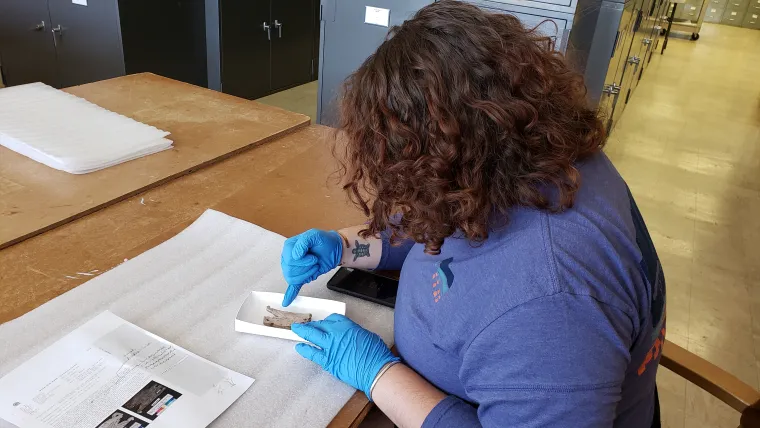
Adri Boudrieau analyzing the "Shellman" pendant (2005-498-3).
The Curiosities of the Shellman Site
By Adri Boudrieau
ASM Archaeological Repository Intern
Spring 2021
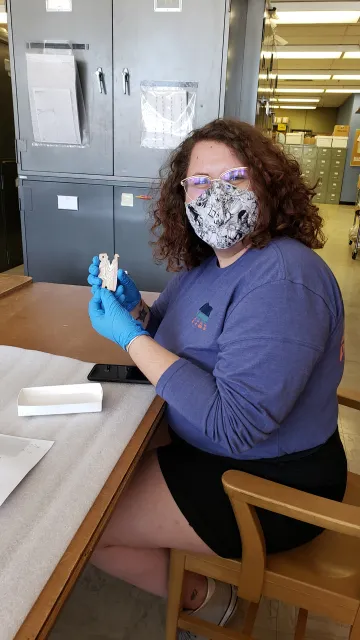
Adri Boudrieau with the "Shellman" pendant (2005-498-3).
The ASM Repository is well known among U of A Anthropology students as the place to intern if you have any interest in archaeology and/or museum collections. As someone who has an interest in both, I had been attempting to fit an internship into my schedule since my first semester. That same internship taking place during a worldwide pandemic was not really the plan, but it did lend to some unique experiences and opportunities.
My first semester at the repository consisted of assisting with the backlog of collections. This meant going through many collections in storage at the repository in order to establish a database location and statuses for the in-process collections. Looking through so many various collections I got to see and learn about many different objects and types. It really felt like adventuring through all the hidden gems of the ASM, all the things not fully processed and not displayed to the public through the museum. While my fellow intern and I constantly joked about the ‘rock trays’ which held the ground stone objects, including manos and axe heads, every new tray I pulled held new mysteries. And while I certainly had fun, getting credits for snooping through dozens of trays of artifacts, there were certainly some challenging moments and learning a new skill set is never easy. During the approximate three months I worked on the backlog inventory, I assessed 2064 objects across 12 collections which included a wide variety from large heavy manos to delicately carved shell pieces and charming ceramic vessels. So, when I decided I was coming back for another semester, and I was given the opportunity to choose a collection to focus on, I was faced with more options than I would have liked.

2005-498-3: An anthropomorphic shell pendant, titled the Shellman.
The collections I had worked with during my first couple of months were considered ‘In Progress,’ meaning that in some way the cataloging process had been started. The meaning of ‘In Progress’ varied from collection to collection, with the processing of some nearly complete and others barely started. Considering I would be spending the next semester on completing the catalog process of a particular collection, I wanted a collection that interested me but also was mostly incomplete, in order to get the most experience out of my time here as possible. I eventually decided on the Quail Creek Data Recovery project (ASM Accession 2005-498), excavated by WestLand Resources, Inc., an Arizona-based Cultural Resources Management company (see Cook 2006). Over the course of this project, multiple archaeological sites were excavated. In this post, I will focus on AZ EE:1:317 (ASM), known as the Shellman site. This collection had a wide variety of material, and many objects that captured my attention. In particular, I was interested in knowing more about the stone effigy vessel, ceramic figurines, and the shell assemblage, best known for the Shellman pendant. Shown below are some of my favorite artifacts from this collection, as well a bit about the site and the importance of these objects.
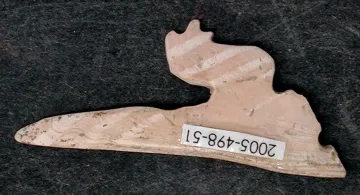
2005-498-51: A zoomorphic shell pendant representing the back half of a coyote or cipactli.
The Shellman site is located in the Santa Cruz River valley, just south of Tucson near Sahuarita. It lies just east of the river, low down on the Santa Rita Mountains. While the area of Tucson has been well documented by archaeologists, the lack of development in the surrounding areas means the sites of these areas are not as well known. So, when development in the areas of Sahuarita and Green Valley revealed numerous sites of the Southern Tucson Basin, projects began spawning. The Southern Tucson Basin is known to have been inhabited by the Hohokam, a prehistoric culture of south-central Arizona from 750-1450 CE. The Hohokam was made up by a variety of ethnic groups, polities, and alliances, and the Tucson Basin Hohokam was a peripheral area linked to the core in the Salt-Gila Basin. This site, in particular dates to 800 – 1150 CE, putting the site into the Colonial and Sedentary periods.

2005-498-60:Underneath of large, plain bracelet fragment showing incised notches.
The most recognizable artifact from this site, by far, is the Shellman pendant (2005-498-3; Vokes 2006: 4.4)). The pendant is cut from an abalone shell and depicts a man with a staff. The shell is certainly a marvelous artifact, large and well-preserved. The surface is pearlescent, reflecting bright blues, greens, and pinks along its surface. A single perforation at the top has wear suggesting the pendant was worn, most likely by an individual of significance. The pendant itself is of great significance. While anthropomorphic depictions are well known, especially in ceramics, and shell is certainly a common find, the appearance of human imagery in shell is rather rare. The ones that do exist are typically posed frontal, while the Shellman is in profile and wielding a staff, often associated with authority. The staff has notches that are believed to represent carvings in the staff, which could mirror that of calendar sticks used to track important chronological events. The staff itself is not used as a crutch, appearing to be held more symbolically than for a purpose. The knobbed top appears to be a bird head in profile, with a curved beak reminiscent of raptorial birds. The combination of possible cultural use of the staff, the symbolic holding of the staff, and the animal imagery all lends itself to suggesting this is a depiction of an individual of authority or potentially as a symbol of the role itself. While it cannot be clearly determined if this is a representation of a specific individual, or a more abstract conceptualization of a rank, the Shellman stands out as a remarkable specimen and a testament to the people of the past.

2005-498-61: A decorated bracelet fragment.
While the Shellman pendant certainly stands out as a wondrous example of shell jewelry, the pendant is not the only remarkable shell artifact from the site. The assemblage of shell goods includes a number of beads, pendants, and bracelets. Similar to the Shellman, a single cut pendant fragment of the back half of an animal has been recovered (2005-498-51; Vokes 2006: 4.4). The pendant retains the hind legs and tail of the animal. While it may be first recognized as the back half of a lizard, it is more likely to be a coyote or cipactli depicted in a dynamic movement. These depictions are not uncommon and are quite well known in Hohokam assemblages.
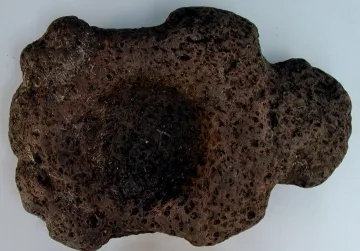
2005-498-34: A stone effigy vessel in the shape of either a frog or tortoise.
The bracelets are the most common shell artifact finds from this site, and of most shell assemblages. Of the bracelets, one stands out for being the largest, consisting of a thick band and representing about half of the original bracelet (2005-498-60; Vokes 2006: 4.6). The bracelet is plain, and undecorated, with the exception of a series of incised notches along the underneath edge. This bracelet still retains the ‘beak’ shape of the umbo of the shell, a common feature among the bracelets of the Shellman site, which is even accentuated by grinding the underneath to make the shape more prominent. The site also turned up several decorated bracelets, including a decent sized section of a bracelet with notching on either edge (2005-498-61; Vokes 2006: 4.6). The bracelet is of particular interest as it may be representative of a design stage along a continuum. Designs may have begun with a practice of shallow, incised nicking, to a later preference of scalloped edges that may represent the movement of a snake’s body.
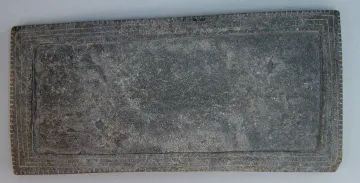
2005-498-35: A complete bordered palette.
As wondrous as the shell is to look at, the existence of these artifacts in the deserts of the Tucson Basin is a testament to the history of trade among the natives of America. Looking at this shell is like looking through the history of passing hands and the gathering of people. As Arthur Vokes’ analysis has shown the shell from this site was sourced from the Gulf of California, well over 300 miles away. While that is certainly a travelable distance and direct procurement of the shell cannot be fully ruled out, it is significantly more likely that the shell was part of a system of exchange. There are two known trade routes known to have existed around the area of the Southern Tucson Basin near the period of inhabitation of Shellman (Vokes 2006: 4.14-4.16). One of these came from the South and was dominant in the area of the upper and middle Santa Cruz river. The other comes from the North, crossing over the Papaguería. It is most likely that the site was using both systems, considering the proximity of the Southern route and the abalone shell, which could only have come from the west coast of California via the northern route. The shell assemblage is a testament to the trade of the early Americas and the connection between people.
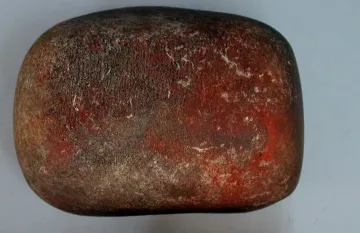
2005-498-22: An ochre-stained handstone used in the processing of pigments.
Shell was the material class that initially caught my interest. However, there was a great amount of cultural material collected from the Shellman site, and many pieces of interest. Groundstone primarily consists of the manos and other stone used to grind seeds and plants. Among the large manos and other grinding tools, are some more unusual stone artifacts. This includes a stone effigy vessel (2005-498-34; Buckles and Chenault 2006: 6.7), a shaped stone with a basin-shaped ‘bowl’ in the top. The stone has been carved into the likeness of an animal, most likely that of a frog or tortoise. Frog iconography is rather common and thus more likely, despite my initial impulse to label it as a tortoise. The basin has signs of burning and is believed to have been used to burn incense.
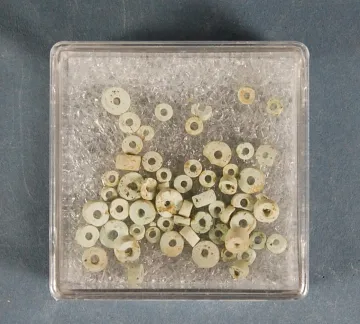
2005-498-30: A collection of turquoise beads that made up a necklace.
Pigments were also uncovered at the site, including two worked pieces and a processed cake. The processed cake and one of the worked pieces, referred to by the researchers as ‘crayons,’ were made of ochre, while the last piece was made from white kaolinite (common in Mogollon and Anasazi contexts, but quite rare for Hohokam). Additionally, a whole bordered palette (2005-498-35; Buckles and Chenault 2006: 6.6) was located with the two ‘crayons,’ though it has no staining which would indicate use with the pigments. Despite the association through provenience, the lack of staining on the palette makes it difficult to determine if the palette was used with the pigments or not. Pigment processing was certainly occurring as the pigment cake as well as an ochre-stained hand stone (2005-498-22; Buckles and Chenault 2006: 6.10) prove, though these objects were found at another feature.
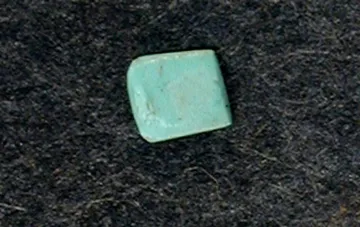
2005-489-29: A single turquoise tessera.
Among the more common groundstone finds, a number of interesting objects likely used for personal adornment were recovered (Buckles and Chenault 2006: 6.10). This includes a selection of turquoise beads (2005-498-30), a red argillite pendant (2005-498-28), and a single turquoise tessera (2005-498-29). There was a total of 62 beads in the catalog lot associated with 2005-498-30, six of which were fragmentary. The beads were all found together in the remains of a canine mortuary feature and are believed to have been a singular necklace that was placed on top of the dog before burial. The beads are all circular, with slight variation in thickness.
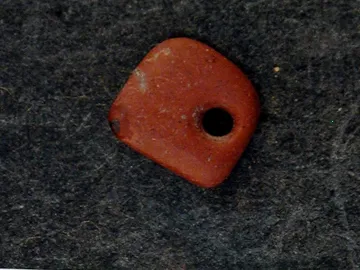
2005-498-28: A red argillite pendant.
The turquoise used to make the tessera is high quality with a vibrant hue. Tesserae are the small shapes of rock, glass, and ceramic that are used to make mosaics. The tessera from the Shellman site is quite small, only 3.5 mm wide, and was the only piece recovered. The pendant is made from a bright red argillite, which has been ground into a subrectangular shape and drilled through to be strung. While these pieces are not the most informative about the people that resided at the Shellman site, they stand as testaments to the craftsmanship and culture of the Hohokam people.
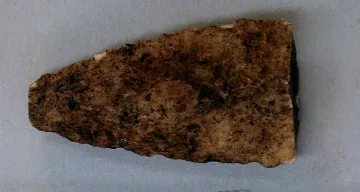
2005-498-84: An unspecified Archaic projectile point fragment.
Lithics consist of stone that has been chipped and flaked to form tools and other implements. Most recognizable and commonly discussed of these are projectile points. The site had many points uncovered during the excavation, but one in particular stands out among the rest, the projectile point associated with 2005-498-84 (Harrison 2006: 7.6). The point fragment is triangular in shape, and despite being made of a white chert, appears dark brown due to organic residue across the surface. What is most interesting about this point, however, is that the excavators believe that this projectile point dates to the Archaic Period (8,500 BCE – 500 CE; Harrison, 2006: 7.6). Typologically, the point fragment has the large size, serrated edge, and lenticular (eye-shaped) cross-section associated with Archaic points. Since only the blade remains, the dating cannot be absolute but the possibility of an Archaic point in a Hohokam site is quite perplexing. Another possibly Archaic point was found in a site nearby during the same excavation project, so it is possible that the sites were occupied periodically throughout time, or that the Hohokam were making Archaic style points (Harrison, 2006: 7.15). Additionally, this artifact could be the result of the heirloom affect, where an object gets passed down through generations. This single artifact raises more questions than it gives answers, making a perplexing and fascinating piece. It is unknown how it ended up in the Hohokam site, but the possibilities are numerous.
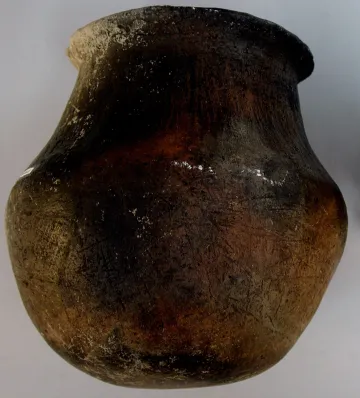
2005-498-117: A plain ware jar with vertical scoring around the neck.
The ceramic assemblage is interesting, as well. Two almost whole vessels, including a plain-ware bowl made using a cloth-lined mold which has a chipped rim, and a whole plain-ware jar with vertical scoring marks around the neck (2005-498-117; Gregonis 2006: 8.7). However, there also are several miniature vessels (e.g., 2005-498-108) that survive mostly intact. These consist of a Sacaton Red-on-buff miniature cauldron, and two miniature jars. These vessels were most likely used for the processing and storing of medicines and other herbs (Gregonis, 2006: 8.7-8.8). One of the miniature jars is a pinch-made vessel that is smaller than the others and is believed to have been used for storing valuable materials in small amounts (Gregonis, 2006: 8.7-8.8). I admit, however, that my personal interest in these is their cute appearance, and how fascinating it is that throughout human history to modern times, we seem drawn to miniature things. Despite our modern perception to find these vessels more charming than functional, they certainly had their uses in the past.
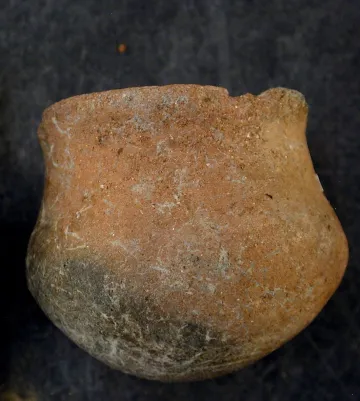
2005-498-108: A miniature plain ware vessel.
I am also fascinated and charmed by depictions of animals in art, from the earliest cave paintings to modern day. The ceramic sherds of the Shellman site, with animal iconography depictions on Hohokam pottery, are no different. While the vessel fragments have a wide array of gorgeous designs, including a sizable sherd covered in an interlocking scroll pattern (2005-498-86; Gregonis 2006: 8.6), there are a number of fragments with animal imagery.
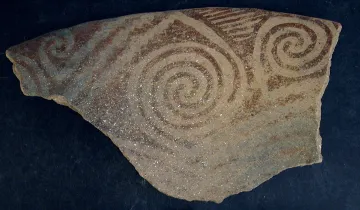
2005-498-86: A Red-on-buff sherd from a flared-rim bowl with an interior design of interlocking scrolls.
One of these fragments is a group of three sherds that refit together depicting the head of an animal, most likely of a lizard or snake (2005-498-98; Gregonis 2006: 8.6). The design is from the interior of a flare-rimmed bowl, a common vessel form from this site. The overall design is composed of alternating columns of oblique dashes and the zoomorphic images in otherwise solid bands. The design is painted onto the vessel with red paint. The animal, to me, appears to be that of a snake as the head is diamond-esque, but without the full image it cannot be a certain identification.
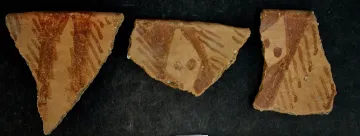
2005-498-89: Three ceramic sherds with snake or lizard imagery.
The sherd that is my personal favorite from this site is a pair that depicts a bird design across the exterior surface (2005-498-98). This design was also done in red paint. The birds consist of a large circular head with a prominent beak and a dot representing an eye, attached to the body via a long, curved neck, a classic Hohokam design. To me, they appear to be turkeys, due to the neck shape and the design of the feathers, however that is certainly not a diagnostic determination. Bird iconography is probably the most common animal iconography in the southwest, though the forms typically become abstracted into forms that vaguely resemble the image of a flying bird (Haury 1976:243).
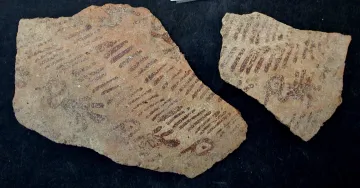
2005-498-98: Two ceramic sherds with a design of birds and oblique dashes.
Beyond the fragmentary sherds, this site also had a number worked sherds, an object type defined as pieces of pottery that broke in antiquity and refashioned into other things. While this included disks and other shapes, most interesting to me and of import are the subrectangular and boomerang shaped pieces (e.g., 2005-498-90). A number of them were uncovered, often in sets together. It is believed that these pieces were used in some form of stick-toss game, as was known to be played by the historical O’odham people using painted wood (Gregonis, 2006: 8.9). The game would have been played by flipping the sherd in the air and gaining points based upon its landing point. The concept is quite similar to the present-day game of horseshoes, where the goal is to get it on or as close to the pole as possible. Though the game in antiquity certainly was played differently, and the pieces are not shaped correctly to indicate the aim was to get them wrapped around something, but nevertheless the premise is similar (Gregonis, 2006: 8.9-8.10). A particularly lovely piece was made from a Sacaton Red-on-buff sherd (2005-498-90; Gregonis 2006: 8.9), and still retains the prominent design, where others have faded or had their designs smudged out. Other pieces included two dog-bone shaped sherds found along with 2005-498-90, a single decorated sherd and two smudged and darkened sherds found together and believed to be a set.
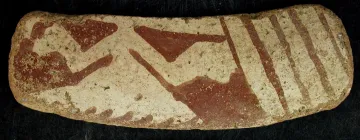
2005-498-90: A boomerang-shaped worked sherd of Sacaton Red-on-buff believed to have been used in a stick-toss game.
Beyond vessels, human figurines made of clay were recovered from the Shellman site. One of the two reconstructible figurines is nearly complete (2005-498-111; Gregonis 2006: 8.10), though broken into three pieces. These figures were made from dark clay, and then smoke blackened. The more complete figurine is an armless human figure with rounded shoulders where the arms should be, breasts and wide-set, forward thrusted hips. The head is wide and set on a nearly as wide neck. A roll of clay on the head of the figure is believed to represent a headdress. The facial features, as well as a pattern across the torso and legs, likely representing garments, are depicted through lines incised into the clay. The figurines are from different features (Features 33 and 34) but are both dated to the Rillito-phase and resemble figurines from the Gila Valley and Tucson Basin (Gregonis, 2006: 8.10). In addition to the two figurines, a number of other figurine fragments were recovered, including a lone torso. In addition to the human figurines, fragmentary pieces of animal figurine limbs were recovered.

2005-498-111: reconstructed ceramic figurine with incised detailing.
This brief selection does not even begin to fully summarize all of the artifacts recovered from the Shellman site. However, it does give a brief overview of the diverse selection, as well as the many curious finds of the site. While the site may be best known for the Shellman, who is without a doubt a marvelous artifact, the collection is filled with amazing objects and uncommon finds. The Arizona State Museum Repository is filled with hidden mysteries, and fascinating objects, but this has been a look at some of my favorites.
References Cited
Buckles, Avi and Mark L. Chenault
2006 Chapter Six: Ground Stone Analysis. In The Cultural Resources of Quail Creek: Volume One: Archaeological Excavations at AZ EE:1:317 (Shellman), AZ EE:1:275, AZ EE:1:175, AZ EE:1:176, and AZ EE:1:302, edited by Mike Cook, pp. 6.1-6.13. WestLand Cultural Resources Report No. 2006-42. Arizona State Museum Accession Number 2005-498.
Cook, Michael D. (editor)
2006 The Cultural Resources of Quail Creek: Volume One: Archaeological Excavations at AZ EE:1:317 (Shellman), AZ EE:1:275, AZ EE:1:175, AZ EE:1:176, and AZ EE:1:302. WestLand Cultural Resources Report No. 2006-42. Arizona State Museum Accession Number 2005-498.
Harrison, James
2006 Chapter Seven: Flaked Stone Analysis. In The Cultural Resources of Quail Creek: Volume One: Archaeological Excavations at AZ EE:1:317 (Shellman), AZ EE:1:275, AZ EE:1:175, AZ EE:1:176, and AZ EE:1:302, edited by Mike Cook, pp. 7.1-7.15. WestLand Cultural Resources Report No. 2006-42. Arizona State Museum Accession Number 2005-498.
Haury, Emil
1976 The Hohokam, Desert Farmers & Craftsmen: Excavations at Snaketown, 1964-1965. Tucson: The University of Arizona Press.
Gregonis, Linda
2006 Chapter Eight: Ceramic Analysis. In The Cultural Resources of Quail Creek: Volume One: Archaeological Excavations at AZ EE:1:317 (Shellman), AZ EE:1:275, AZ EE:1:175, AZ EE:1:176, and AZ EE:1:302, edited by Mike Cook, pp. 8.1-8.44. WestLand Cultural Resources Report No. 2006-42. Arizona State Museum Accession Number 2005-498.
Vokes, Arthur W.
2006 Chapter Four: Shell Analysis. In The Cultural Resources of Quail Creek: Volume One: Archaeological Excavations at AZ EE:1:317 (Shellman), AZ EE:1:275, AZ EE:1:175, AZ EE:1:176, and AZ EE:1:302, edited by Mike Cook, pp. 4.1-4.16. WestLand Cultural Resources Report No. 2006-42. Arizona State Museum Accession Number 2005-498.





